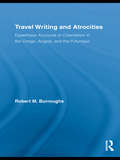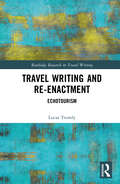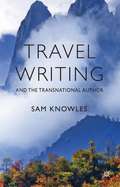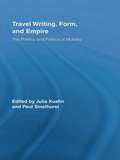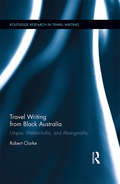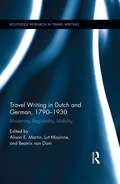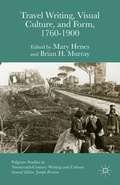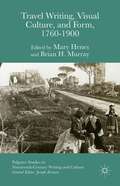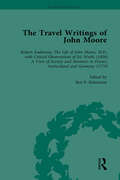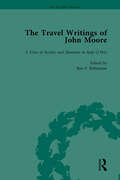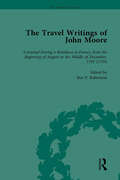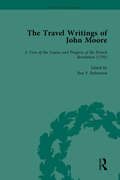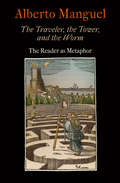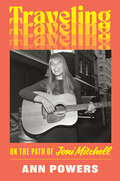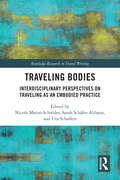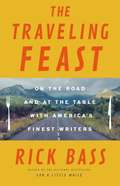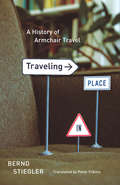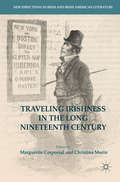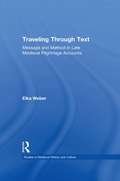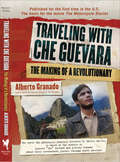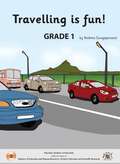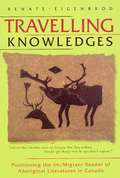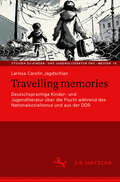- Table View
- List View
Travel Writing and Atrocities: Eyewitness Accounts of Colonialism in the Congo, Angola, and the Putumayo
by Robert M. BurroughsThis book examines eyewitness travel reports of atrocities committed in European-funded slave regimes in the Congo Free State, Portuguese West Africa, and the Putumayo district of the Amazon rainforest during the late-nineteenth and early-twentieth centuries. During this time, British explorers, missionaries, consuls, journalists, soldiers, and traders produced evidence of misrule in the Congo, Angola, and the Putumayo, which they described their travel and witnessing of colonial violence in travelogues, ethnographic monographs, consular reports, diaries and letters, sketches, photography, and more. As well as bringing home to readers ongoing brutalities, eyewitness narratives contributed to debates on humanitarianism, trade, colonialism, and race and racial prejudice in late Victorian and Edwardian Britain. In particular, whereas earlier antislavery travelers had tended to promote British imperial expansion as a remedy to slavery, travel texts produced for the three major humanitarian campaigns of the late-nineteenth and early-twentieth century expressed — and, indeed, gave rise to — changes in the perception of Britain as a nation for whom the protection of Africans remained paramount. Burroughs's study charts the emergence of a subversive eyewitness response in travel writing, which implicated Britons and British industries in the continuing existence of slave labor in regions formally ruled by other nations.
Travel Writing and Re-Enactment: Echotourism (Routledge Research in Travel Writing)
by Lucas TromlyTravel Writing and Re-Enactment: Echotourism explores the popular subgenre of travel narratives that re-enact historically prominent journeys. Drawing on philosopher Walter Benjamin, this monograph reads such re-enactments as quests for aura in which travellers seek to capture a sense of distinction and historical profundity. Travel Writing and Re-Enactment frames the re-enactment of past journeys in a number of contexts, including Benjamin’s writing on mechanical reproduction, Judith Butler’s work on gender performance, and postmodern parody. Echotourist journeys are surprisingly contingent and precarious, and force travellers to navigate historical changes involving empire, gender, and travel practice in densely performative ways. Through close readings of contemporary travel narratives, this monograph considers the legacies of Lord Byron, Charles Darwin, Graham Greene, Mary Kingsley, and Ernest Shackleton, among others. Travel Writing and Re-Enactment examines the way literary re-enactment expresses, and sometimes confounds, the desire to find meaning through travel in the contemporary world.
Travel Writing and the Transnational Author
by Sam KnowlesTravel Writing and the Transnational Author explores the travel writing and transnational literature of four authors from the 'postcolonial canon': Michael Ondaatje, Vikram Seth, Amitav Ghosh, and Salman Rushdie. By focusing on the under-considered influence of the authors' own travel writing on their later work, this book bridges two critical fields: travel writing and transnational literary studies. This results in a unique approach that interrogates both areas of study, while also complementing existing criticism on all four authors. Through an analysis of the links between their travel writing and later literature, Travel Writing and the Transnational Author re-considers what it means to travel, write, and exist as a contemporary transnational individual. Each chapter contains an in-depth analysis of selected texts both early travelogues and later transnational literature and the introduction gives background on the politics and poetics of the authors alongside a well-informed overview of topics such as postcolonial and travel writing studies. "
Travel Writing, Form, and Empire: The Poetics and Politics of Mobility (Routledge Research in Travel Writing)
by Julia Kuehn Paul SmethurstThis collection of essays is an important contribution to travel writing studies -- looking beyond the explicitly political questions of postcolonial and gender discourses, it considers the form, poetics, institutions and reception of travel writing in the history of empire and its aftermath. Starting from the premise that travel writing studies has received much of its impetus and theoretical input from the sometimes overgeneralized precepts of postcolonial studies and gender studies, this collection aims to explore more widely and more locally the expression of imperialist discourse in travel writing, and also to locate within contemporary travel writing attempts to evade or re-engage with the power politics of such discourse. There is a double focus then to explore further postcolonial theory in European travel writing (Anglophone, Francophone and Hispanic), and to trace the emergence of postcolonial forms of travel writing. The thread that draws the two halves of the collection together is an interest in form and relations between form and travel.
Travel Writing from Black Australia: Utopia, Melancholia, and Aboriginality (Routledge Research in Travel Writing)
by Robert ClarkeOver the past thirty years the Australian travel experience has been 'Aboriginalized'. Aboriginality has been appropriated to furnish the Australian nation with a unique and identifiable tourist brand. This is deeply ironic given the realities of life for many Aboriginal people in Australian society. On the one hand, Aboriginality in the form of artworks, literature, performances, landscapes, sport, and famous individuals is celebrated for the way it blends exoticism, mysticism, multiculturalism, nationalism, and reconciliation. On the other hand, in the media, cinema, and travel writing, Aboriginality in the form of the lived experiences of Aboriginal people has been exploited in the service of moral panic, patronized in the name of white benevolence, or simply ignored. For many travel writers, this irony - the clash between different regimes of valuing Aboriginality - is one of the great challenges to travelling in Australia. Travel Writing from Black Australia examines the ambivalence of contemporary travelers' engagements with Aboriginality. Concentrating on a period marked by the rise of discourses on Aboriginality championing indigenous empowerment, self-determination, and reconciliation, the author analyses how travel to Black Australia has become, for many travelers, a means of discovering 'new'--and potentially transformative--styles of interracial engagement.
Travel Writing in Dutch and German, 1790-1930: Modernity, Regionality, Mobility (Routledge Research in Travel Writing)
by Alison E. Martin Lut Missinne Beatrix Van DamThis volume focuses on how travel writing contributed to cultural and intellectual exchange in and between the Dutch- and German-speaking regions from the 1790s to the twentieth-century interwar period. Drawing on a hitherto largely overlooked body of travelers whose work ranges across what is now Germany and Austria, the Netherlands and Dutch-speaking Belgium, the Dutch East Indies and Suriname, the contributors highlight the interrelations between the regional and the global and the role alterity plays in both spheres. They therefore offer a transnational and transcultural perspective on the ways in which the foreign was mediated to audiences back home. By combining a narrative perspective on travel writing with a socio-historically contextualized approach, essays emphasize the importance of textuality in travel literature as well as the self-positioning of such accounts in their individual historical and political environments. The first sustained analysis to focus specifically on these neighboring cultural and linguistic areas, this collection demonstrates how topographies of knowledge were forged across these regions by an astonishingly diverse range of travelling individuals from professional scholars and writers to art dealers, soldiers, (female) explorers, and scientific collectors. The contributors address cultural, aesthetic, political, and gendered aspects of travel writing, drawing productively on other disciplines and areas of scholarly research that encompass German Studies, Low Countries Studies, comparative literature, aesthetics, the history of science, literary geography, and the history of publishing.
Travel Writing, Visual Culture, and Form, 1760-1900 (Palgrave Studies in Nineteenth-Century Writing and Culture)
by Mary HenesThis collection reveals the variety of literary forms and visual media through which travel records were conveyed in the long nineteenth century, bringing together a group of leading researchers from a range of disciplines to explore the relationship between travel writing, visual representation and formal innovation.
Travel Writing, Visual Culture and Form, 1760–1900 (Palgrave Studies in Nineteenth-Century Writing and Culture)
by Mary HenesThis collection reveals the variety of literary forms and visual media through which travel records were conveyed in the long nineteenth century, bringing together a group of leading researchers from a range of disciplines to explore the relationship between travel writing, visual representation and formal innovation.
The Travel Writings of John Moore Vol 1 (The\pickering Masters Ser.)
by Ben P RobertsonJohn Moore was a Scottish physician who travelled extensively and wrote immensely popular accounts of these, which brought him international fame. Despite this, his travel writings have not been available since 1820. This collection will be the first in almost two centuries to present his Travel Writings to historians and literary scholars.
The Travel Writings of John Moore Vol 2 (The\pickering Masters Ser.)
by Ben P RobertsonJohn Moore was a Scottish physician who travelled extensively and wrote immensely popular accounts of these, which brought him international fame. Despite this, his travel writings have not been available since 1820. This collection will be the first in almost two centuries to present his Travel Writings to historians and literary scholars.
The Travel Writings of John Moore Vol 3 (The\pickering Masters Ser.)
by Ben P RobertsonJohn Moore was a Scottish physician who travelled extensively and wrote immensely popular accounts of these, which brought him international fame. Despite this, his travel writings have not been available since 1820. This collection will be the first in almost two centuries to present his Travel Writings to historians and literary scholars.
The Travel Writings of John Moore Vol 4 (The\pickering Masters Ser.)
by Ben P RobertsonJohn Moore was a Scottish physician who travelled extensively and wrote immensely popular accounts of these, which brought him international fame. Despite this, his travel writings have not been available since 1820. This collection will be the first in almost two centuries to present his Travel Writings to historians and literary scholars.
The Traveler, the Tower, and the Worm
by Alberto ManguelAs far as one can tell, human beings are the only species for which the world seems made up of stories, Alberto Manguel writes. We read the book of the world in many guises: we may be travelers, advancing through its pages like pilgrims heading toward enlightenment. We may be recluses, withdrawing through our reading into our own ivory towers. Or we may devour our books like burrowing worms, not to benefit from the wisdom they contain but merely to stuff ourselves with countless words.With consummate grace and extraordinary breadth, the best-selling author of A History of Reading and The Library at Night considers the chain of metaphors that have described readers and their relationships to the text-that-is-the-world over a span of four millennia. In figures as familiar and diverse as the book-addled Don Quixote and the pilgrim Dante who carries us through the depths of hell up to the brilliance of heaven, as well as Prince Hamlet paralyzed by his learning, and Emma Bovary who mistakes what she has read for the life she might one day lead, Manguel charts the ways in which literary characters and their interpretations reflect both shifting attitudes toward readers and reading, and certain recurrent notions on the role of the intellectual: "We are reading creatures. We ingest words, we are made of words. . . . It is through words that we identify our reality and by means of words that we ourselves are identified."
Traveling: On the Path of Joni Mitchell
by Ann Powers*An Observer Best New Biographies of 2024*Celebrated NPR music critic Ann Powers explores the life and career of Joni Mitchell in a lyrical style as fascinating and ethereal as the songs of the artist herself..“What you are about to read is not a standard account of the life and work of Joni Mitchell. Instead, it’s a tale of long journeying through a life that changed popular music: of a homesick wanderer forging ahead on routes of her own invention, and of me on her trail, heading toward the ringing of her voice.”—From the introductionFor decades, Joni Mitchell’s life and music have enraptured listeners. One of the most celebrated artists of her generation, Mitchell has inspired countless musicians—from peers like James Taylor, to inheritors like Prince and Brandi Carlile—and authors, who have dissected her music and her life in their writing. At the same time, Mitchell has always been a force beckoning us still closer, as—with the other arm—she pushes us away. Given this, music critic Ann Powers wondered if there was another way to draw insights from the life of this singular musician who never stops moving, never stops experimenting.In Traveling, Powers seeks to understand Mitchell through her myriad journeys. Through extensive interviews with Mitchell's peers and deep archival research, she takes readers to rural Canada, mapping the singer’s childhood battle with polio. She charts the course of Mitchell’s musical evolution, ranging from early folk to jazz fusion to experimentation with pop synthetics. She follows the winding road of Mitchell’s collaborations with other greats, and the loves that emerged along the way, all the way through to the remarkable return of Mitchell to music-making after the 2015 aneurysm that nearly took her life.Along this journey, Powers’ wide-ranging musings on the artist’s life and career reconsider the biographer’s role and the way it twines against the reality of a fan. In doing so, Traveling illustrates the shifting nature of biography, and the ultimate contradiction of celebrity: that an icon cannot truly, completely be known to a fan.Kaleidoscopic in scope, and intimate in its detail, Traveling is a fresh and fascinating addition to the Joni Mitchell canon, written by a biographer in full command of her gifts who asks as much of herself as of her subject.
Traveling Bodies: Interdisciplinary Perspectives on Traveling as an Embodied Practice (Routledge Research in Travel Writing)
by Nicole Maruo-Schröder, Sarah Schäfer-Althaus, and Uta SchaffersTraveling Bodies: Interdisciplinary Perspectives on Traveling as an Embodied Practice explores the central role the body has in and for traveling and thus complements and expands upon existing research in travel studies with new perspectives on and insights in the entanglement of bodies and traveling. The case studies assembled in this volume discuss a variety of traveling practices, experiences, and media with chapters featuring Asian, American, and European historical and contemporary perspectives. Truly interdisciplinary in its approach, the volume identifies and examines diverse literary, historical and cultural texts, contexts, and modes in which traveling and the body intersect, including ‘classic’ travelogues, (new) media (e.g., film, digital travel apps), surf culture, and travel-inspired tattoos. The contributions offer various avenues for further research, not only for scholars working with body theory and travel (writing), but also for anyone interested in the intersections of literature, culture, media, and embodied practices of traveling.
The Traveling Feast: On the Road and at the Table with My Heroes
by Rick BassAcclaimed author Rick Bass decided to thank all of his writing heroes in person, one meal at a time, in this "rich smorgasbord of a memoir . . . a soul-nourishing, road-burning act of tribute" (New York Times Book Review). "Exuberant . . . A classic . . . This is a rich bounty of a book." --Publishers Weekly (starred review)"A master."--Boston Globe "One of the very best writers we have."--San Francisco Chronicle "Both mythic and intimate . . . A virtuoso."--O: The Oprah Magazine "The beauty of his sentences recalls the stylistic finesse of Cormac McCarthy and Willa Cather."--Chicago TribuneFrom his bid to become Eudora Welty's lawn boy to the time George Plimpton offered to punch him in the nose, lineage has always been important to Rick Bass. Now at a turning point--in his midfifties, with his long marriage dissolved and his grown daughters out of the house--Bass strikes out on a journey of thanksgiving. His aim: to make a memorable meal for each of his mentors, to express his gratitude for the way they have shaped not only his writing but his life. The result, an odyssey to some of America's most iconic writers, is also a record of self-transformation as Bass seeks to recapture the fire that drove him as a young man. Along the way we join in escapades involving smuggled contraband, an exploding grill, a trail of blood through Heathrow airport, an episode of dog-watching with Amy Hempel in Central Park, and a near run-in with plague-ridden prairie dogs on the way to see Lorrie Moore, as well as heartwarming and bittersweet final meals with the late Peter Matthiessen, John Berger, and Denis Johnson. Poignant, funny, and wistful, The Traveling Feast is a guide to living well and an unforgettable adventure that nourishes and renews the spirit.
Traveling in Place: A History of Armchair Travel
by Bernd StieglerArmchair travel may seem like an oxymoron. Doesn’t travel require us to leave the house? And yet, anyone who has lost herself for hours in the descriptive pages of a novel or the absorbing images of a film knows the very real feeling of having explored and experienced a different place or time without ever leaving her seat. No passport, no currency, no security screening required—the luxury of armchair travel is accessible to us all. In Traveling in Place, Bernd Stiegler celebrates this convenient, magical means of transport in all its many forms. Organized into twenty-one “legs”—or short chapters—Traveling in Place begins with a consideration of Xavier de Maistre’s 1794 Voyage autour de ma chambre, an account of the forty-two-day “journey around his room” Maistre undertook as a way to entertain himself while under house arrest. Stiegler is fascinated by the notion of exploring the familiar as though it were completely new and strange. He engages writers as diverse as Roussel, Beckett, Perec, Robbe-Grillet, Cortázar, Kierkegaard, and Borges, all of whom show how the everyday can be brilliantly transformed. Like the best guidebooks, Traveling in Place is more interested in the idea of travel as a state of mind than as a physical activity, and Stiegler reflects on the different ways that traveling at home have manifested themselves in the modern era, from literature and film to the virtual possibilities of the Internet, blogs, and contemporary art. Reminiscent of the pictorial meditations of Sebald, but possessed of the intellectual playfulness of Calvino, Traveling in Place offers an entertaining and creative Baedeker to journeying at home.
Traveling in Place: A History of Armchair Travel
by Bernd Stiegler translated by Peter FilkinsArmchair travel may seem like an oxymoron. Doesn't travel require us to leave the house? And yet, anyone who has lost herself for hours in the descriptive pages of a novel or the absorbing images of a film knows the very real feeling of having explored and experienced a different place or time without ever leaving her seat. No passport, no currency, no security screening required--the luxury of armchair travel is accessible to us all. In Traveling in Place, Bernd Stiegler celebrates this convenient, magical means of transport in all its many forms. Organized into twenty-one "legs"--or short chapters--Traveling in Place begins with a consideration of Xavier de Maistre's 1794 Voyage autour de ma chambre, an account of the forty-two-day "journey around his room" Maistre undertook as a way to entertain himself while under house arrest. Stiegler is fascinated by the notion of exploring the familiar as though it were completely new and strange. He engages writers as diverse as Roussel, Beckett, Perec, Robbe-Grillet, Cortázar, Kierkegaard, and Borges, all of whom show how the everyday can be brilliantly transformed. Like the best guidebooks, Traveling in Place is more interested in the idea of travel as a state of mind than as a physical activity, and Stiegler reflects on the different ways that traveling at home have manifested themselves in the modern era, from literature and film to the virtual possibilities of the Internet, blogs, and contemporary art. Reminiscent of the pictorial meditations of Sebald, but possessed of the intellectual playfulness of Calvino, Traveling in Place offers an entertaining and creative Baedeker to journeying at home.
Traveling Irishness in the Long Nineteenth Century
by Marguérite Corporaal Christina MorinExploring the effects of travelling, migration, and other forms of cultural contact, particularly within Europe, this edited collection explores the act of traveling and the representation of traveling by Irish men and women from diverse walks of life in the period between Grattan's Parliament (1782) and World War I (1914). This was a period marked by an increasing physical and cultural mobility of Irish throughout Britain, Continental Europe, the Americas, and the Pacific. Travel was undertaken for a variety of reasons: during the Romantic period, the 'Grand Tour' and what is now sometimes referred to as medical tourism brought Irish artists and intellectuals to Europe, where cultural exchanges with other writers, artists, and thinkers inspired them to introduce novel ideas and cultural forms to their Irish audiences. Showing this impact of the nineteenth-century Irish across national borders and their engagement with global cultural and linguistic traditions, the volume will provide novel insights into the transcultural spheres of the arts, literature, politics, and translation in which they were active.
Traveling Through Text: Message and Method in Late Medieval Pilgrimage Accounts (Studies in Medieval History and Culture)
by Elka WeberTraveling through Text compares religious ravel writing by Muslims, Christians and Jews in later Middle Ages. This comparative approach allows us to see that writers in all three religious communities used travel writing in the same way, to shape the perceptions of their readers by asserting the author's authority. The central paradox of religious travel writing is that the travel writer reads about a place, usually in a sacred text, decide to supplement the reading with the empirical experience of visiting and describing the place, and the creates his own descriptive text. But in writing this new book, and in letting his readers know his authorial authority, the travel writer himself is daring the reader to challenge the new text. Is a book ever enough? For societies that value their sacred texts, this question is a challenge. But it is a challenge posed by writers who live firmly in the religious tradition.
Traveling with Che Guevara: The Making of a Revolutionary (Shooting Script Ser.)
by Alberto GranadoPublished for the first time in the U.S.—one of the two diaries on which the movie The Motorcycle Diaries is based—the moving and at times hilarious account of Che Guevara and Alberto Granado's eight-month tour of South America in 1952.In 1952 Alberto Granado, a young doctor, and his friend Ernesto Guevara, a 23-year-old medical student from a distinguished Buenos Aires family, decided to explore their continent. They set off from Cordoba in Argentina on a Norton 500cc motorbike and traveled through Chile, Peru, Colombia, and Venezuela. The duo's adventures vary from the suspenseful (stowing away on a cargo ship, exploring Incan ruins) to the comedic (falling in love, drinking, fighting...) to the serious (volunteering as firemen and at a leper colony). They worked as day laborers along the way—as soccer coaches, medical assistants, and furniture movers. The poverty and exploitation of the native population started the process that was to turn Ernesto—the debonair, fun-loving student—into Che, the revolutionary who had a profound impact on the history of several nations.Originally published in Spanish in Cuba in 1978, the first English translation was published by Random House UK in 2003. The movie, based on Granado's and Che's diaries, directed by Walter Salles (Central Station, Behind the Sun), was produced by Robert Redford and others. Shown at the Sundance Film Festival, it generated great reviews and a frenzied auction for distribution rights, which was won by Focus Features. Granado, now 82, was a consultant to Salles during the production. 10 b/w photos.
Travelling Concepts in the Humanities
by Mieke BalAttempting to bridge the gap between specialised scholarship in the humanistic disciplines and an interdisciplinary project of cultural analysis, Mieke Bal has written an intellectual travel guide that charts the course 'beyond' cultural studies. As with any guide, it can be used in a number of ways and the reader can follow or willfully ignore any of the paths it maps or signposts.Bal's focus for this book is the idea that interdisciplinarity in the humanities - necessary, exciting, serious - must seek its heuristic and methodological basis in concepts rather than its methods. Concepts are not grids to put over an object. The counterpart of any given concept is the cultural text or work or 'thing' that constitutes the object of analysis. No concept is meaningful for cultural analysis unless it helps us to understand the object better on its own terms.Bal offers the reader a sustained theoretical reflection on how to 'do' cultural analysis through a tentative practice of doing just that. This offers a concrete practice to theoretical constructs, and allows the proposed method more accessibility.
Travelling Is Fun! class 1 - MIE
by Reshma Gungapersand"Travelling Is Fun!" unfolds the adventures of Ben, as he embarks on a journey to the airport. En route, he eagerly observes a vibrant array of vehicles, from a big red bus to motorcycles and bicycles, delighting in the unique experiences each mode of transport offers. Upon reaching the airport, Ben's excitement soars as he witnesses the swift flight of an airplane, dreaming of his upcoming journey high in the sky to England. In England, he anticipates the thrill of train travel, weaving in and out of stations, sparking his excitement even further. Through engaging illustrations and simple yet descriptive language, the book captures the allure of travel, igniting a sense of adventure and discovery in young readers.
Travelling Knowledges: Positioning the Im/Migrant Reader of Aboriginal Literatures in Canada
by Renate EigenbrodIn the context of de/colonization, the boundary between an Aboriginal text and the analysis by a non-Aboriginal outsider poses particular challenges often constructed as unbridgeable. Eigenbrod argues that politically correct silence is not the answer but instead does a disservice to the literature that, like all literature, depends on being read, taught, and disseminated in various ways. In Travelling Knowledges, Eigenbrod suggests decolonizing strategies when approaching Aboriginal texts as an outsider and challenges conventional notions of expertise. She concludes that literatures of colonized peoples have to be read ethically, not only without colonial impositions of labels but also with the responsibility to read beyond the text or, in Lee Maracle's words, to become "the architect of great social transformation." Features the works of: Jeannette Armstrong (Okanagan), Louise Halfe (Cree), Margo Kane (Saulteaux/Cree), Maurice Kenny (Mohawk), Thomas King (Cherokee, living in Canada), Emma LaRocque (Cree/Metis), Lee Maracle (Sto:lo/Metis), Ruby Slipperjack (Anishnaabe), Lorne Simon (Miíkmaq), Richard Wagamese (Anishnaabe), and Emma Lee Warrior (Peigan).
Travelling memories: Deutschsprachige Kinder- und Jugendliteratur über die Flucht während des Nationalsozialismus und aus der DDR (Studien zu Kinder- und Jugendliteratur und -medien #15)
by Larissa Carolin JagdschianAufgrund der anhaltenden Fluchtbewegungen fordert Aleida Assmann zur Umstrukturierung national ausgerichteter Erinnerungskulturen auf, damit Flüchtlinge mehr an Erinnerungsprozessen partizipieren können. Diese Forderung greift die Studie am Beispiel der Untersuchung der topografischen und erinnerungskulturellen Darstellungen der Flucht in der Kinder- und Jugendliteratur auf, indem ein Modell des Gedächtnisses der deutschsprachigen Kinder- und Jugendliteratur entwickelt wird. Im Vordergrund stehen zwei historische Phasen: die Flucht während des Nationalsozialismus (1933–1945) und die Flucht aus der Deutschen Demokratischen Republik (1957–1989). Mit der vergleichenden Untersuchung von Exilromanen, realistischen ost- und westdeutschen Kinder- und Jugendromanen nach 1945, DDR-Mädchenromanen, zeitgeschichtlichen und geschichtserzählenden Romanen von u. a. Lisa Tetzner (Die Kinder aus Nr. 67), Kurt Held (Giuseppe und Maria), Erika Mann (A Gang of Ten), Peter Abraham (Die Schüsse der Arche Noah oder die Irrtümer meines Freundes Wensloff), Judith Kerr (Als Hitler das rosa Kaninchen stahl), Lilo Hardel (Karlas große Reise), Brigitte Birnbaum (Reise in den August), Karin König (Ich fühl mich so fifty-fifty), Mirjam Pressler (Malka Mai) und Klaus Kordon (Krokodil im Nacken) wird erstmals das Spektrum der literarischen Gedächtniskonstruktionen von der Flucht während des Nationalsozialismus und aus der Deutschen Demokratischen Republik abgesteckt. Die Studie zeigt in der Verknüpfung von Gedächtnis- und Raumkonzepten, dass sich im Gedächtnis der deutschsprachigen Kinder- und Jugendliteratur die literarischen Gedächtniskonstruktionen über Flucht als „travelling memory“ (Erll 2011) ausgebildet haben. Damit trägt die Studie zur Theoriebildung literaturwissenschaftlicher Gedächtniskonzepte in der Kinder- und Jugendliteraturforschung bei.
